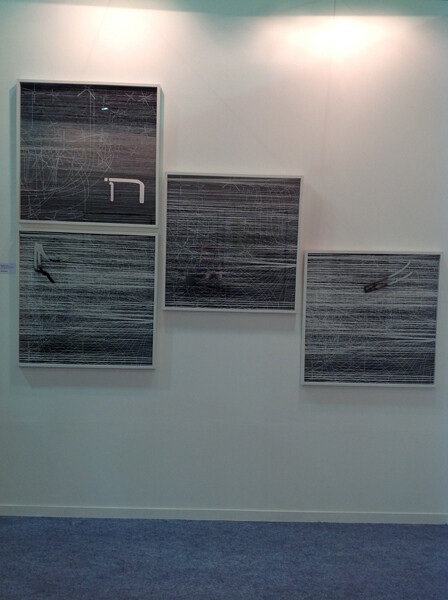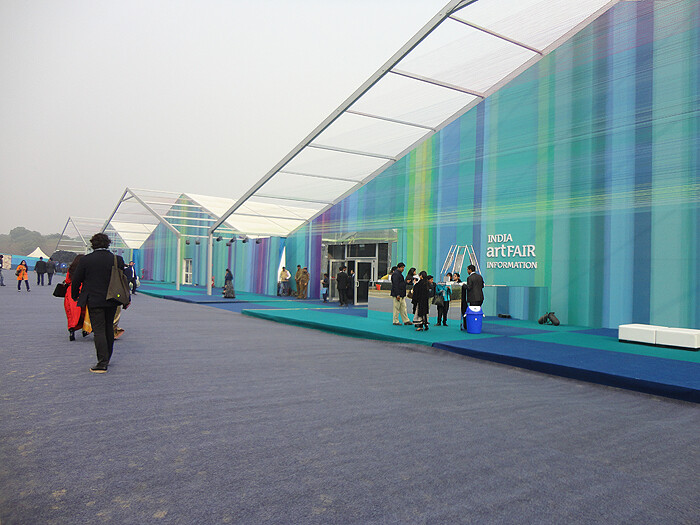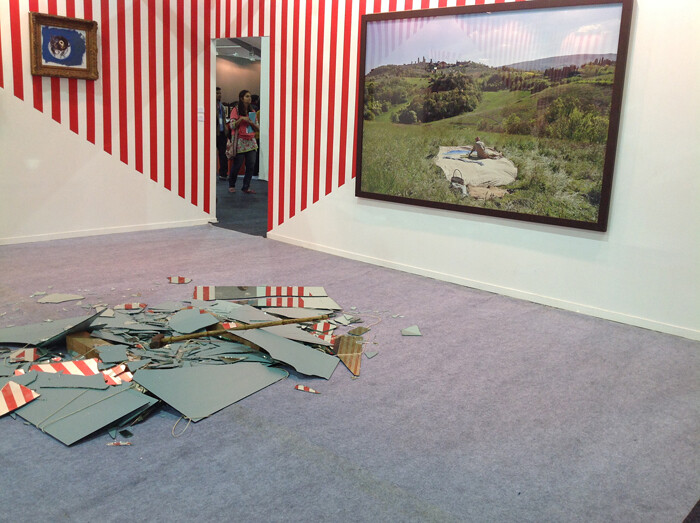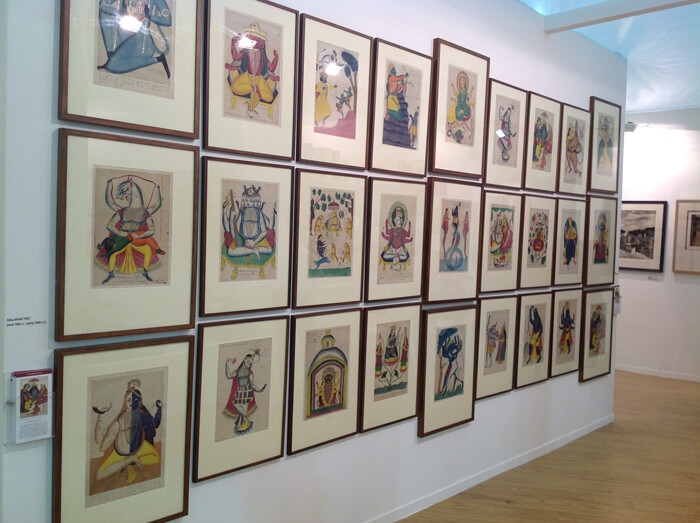Standing in front of Drawings on a Conversation (2012) at the Nature Morte booth in the midst of the 5th India Art Fair, one cannot help but relate its dense and chaotic weave to the general experience of art viewing in Delhi this week. Indeed, this work by Raqs Media Collective feels like inhabiting a conversation that relays back and forth—entanglement after entanglement—until its point of origin is impossible to find. While Raqs constructs an affective inquiry into collective labor, “thought signals,” and body-time relations through this recent series, the trails we can trace out here are somewhat anxious—shuttling between the gigantic tents of the India Art Fair within the exhibition grounds of the National Small Industries Corporation (NSIC) in south Delhi and the cultural venues that lie beyond.
Before arriving at the Indian capital, many had just visited the Jaipur Literature Festival, which is now considered among the major events of the literary world. The India Art Fair has steadily grown since its inception in 2008, attracting not just the routine crowd of fair-hoppers but also independent researchers, museum teams, international students, and most significantly a broad local public. Over the fair’s three-day span, the cultural cartography of Delhi greatly swells with art goers physically negotiating traffic jams and city workers to attend a gamut of openings, lectures, private viewings, special dinners, and events at international embassies.
Prior to the preview day, the Skoda Prize 2012 exhibition unveiled the works of twenty nominated artists at the National Gallery of Modern Art. Though launched only recently, with an exclusive focus on contemporary Indian art, the prize has turned out an impressive list of well-exhibited practices. Some highlights included Praneet Soi’s Astatic Machines (2011–2013), specially designed in the artist’s studio as a combination of cinematic-collage and interactive drawings—a “visual machine” inspired by Paul Klee’s whimsical “Pedagogical Sketchbook,” first published in 1923; Two Stages of Invention (2011) by CAMP, whose collective research strategies interweave the passage of ships and coastal guards within the English Chanel horizon with a theater of “leaks” in governance and the communicative mobility of corruption in contemporary India; and the delightful prints of artist and printmaker T. Venkanna, which addressed polyvalent sexuality. The Skoda Prize winner L. N. Tallur displayed a set of works invested in vocabularies of traditional crafts and their interpretive potential, extending to the contemporary rituals around use and “misuse” of “museum-ized” objects. As part of the Skoda Prize platform, a Breakthrough Artist Award, supported by the publication Art India was awarded to Delhi-based artist Rohini Devasher.
The latest edition of the India Art Fair involved a rise in South Asian participation with Dhaka-based Samdani Art Foundation presenting compelling works by Bangladeshi artists Tayeba Begum Lipi, Ayesha Sultana, and Mohammad Wahiduzzaman, in addition to one of the commissioned art projects at the fair by Mahbubur Rahman, located along the entrance façade. Titled Replacement (2013), his installation consists of a vintage ambassador car stitched over and trailed by a cloud of discarded army boots billowing out of the trunk. In its interior is a fur-lined table with a video projection narrating administrative histories of property ownership in Bangladesh, prior to nationhood and through years of military rule.
Experimenter presented Dhaka/New York-based Naeem Mohaiemen’s Rankin Street 1953 (1,2,3) (2013) which drew from picture albums of a lost family home in Bangladesh. With image memoirs cast in sandstone moulds, the artist effectively visualizes them as sculptural abstractions: anthills, the steps of an agora, and a forest’s edge carved from silhouette figures in an exposed verandah. Just across, Hajra Waheed’s Aerial Studies (1-8) (2013) of fragile transfers on unexposed Polaroids made for interesting counterparts of “negative space” and a paradoxical vulnerability, yet both also serve as blueprints made in defiance of the real.
Many of the international galleries that participated in the previous edition were unfortunately absent this year. Those present have represented contemporary Indian artists for a number of years such as Galleria Continua, whose booth included an “in situ” Daniel Buren piece, which nicely “framed” a photo-performance series Inside Out (2012) by Mumbai/Goa-based artist Nikhil Chopra. Made while in residency at San Gimignano, Chopra rendered its picturesque medieval landscape as literal “drapery”—walking/staging, disappearing/re-appearing through it. Galerie Lelong’s booth was curated by artist Nalini Malani and included her own works set amidst a selection of artists she admires, sensuously linking her practice to that of Ana Mendieta, Kiki Smith, Nancy Spero, Rebecca Horn, Louise Bourgeois, and Jaume Plensa.
Among the solo projects, Kolkata-based gallery Akar Prakar presented an outstanding mini-retrospective of Somnath Hore (1921–2006), a master printmaker, sculptor, and one-time member of the Communist Party of India. His Wounds series, pulp prints made in the 1970s, draws on fields of violence, “[like] pouring acid on a metallic surface,” the artist once remarked. Hore’s works are often non-narrative memory-images, recounting histories of the Bengal famine of 1943, the subcontinent’s partition, and its many wars that he closely witnessed. A series of Hore’s sculptures were placed in the round, among which his undated Boy Holding a Chadar—a bronze sculpture made using the lost-wax technique—is an extraordinarily crafted abject form.
Between thematic panel sessions at the Speakers’ Forum bringing together a dynamic line up of participants including critic-curators Adriano Pedrosa, Chus Martínez, Geeta Kapur, and Barbara London, among others, I slipped back into the fair to view the exceptional works of indigenous women artists, Yamuna Devi (1915–2011) and Chano Devi (1938–2010) at Paris-based collector and gallerist Hervé Perdriolle’s booth. These artists significantly transformed the traditional style of Mithila painting, interspersing native divinities and animist faith-motifs with local botanical and celestial references. Further down, at Delhi Art Gallery was an exquisitely large series of late-nineteenth century Kalighat pats: watercolors embellished with gold, which showcased a variety of deities set in popular legends, and beneath each image was a hand-scrawled description in English, evidencing a history of circulation during the colonial era.
Off-site, the three-part exhibition “Difficult Loves” at the Kiran Nadar Museum of Art (KNMA’s Saket venue) showcased the largest retrospective until now of Nasreen Mohamedi (1937–1990). While Mohamedi’s singular oeuvre has significantly intrigued the art world since it gained exposure through Documenta 12 and other international exhibitions, it is interesting to take note of her as an artistic inspiration for cross-generational practitioners working inside of India. Mohamedi’s diaries are here revealed as captivating palimpsests—scribbled words repeat (“home,” “Nargis,” “Letter Press”) while appointments and memos are set in a rhythm against floating planets and geometric planes. Many works are displayed for the very first time and were found at the artist’s family home by curator Roobina Karode. Elsewhere in the museum one could see a series of portraits of the modernist painter Amrita Sher-Gil (1913–1941), celebrating the centenary of her birth, as well as an exhibition of seven contemporary artists.
There was also an “art night” organized with several exhibition openings at Lado Sarai—Delhi’s gallery district. The evening coincided with live performances and a sound exhibition at a nearby cinema complex, marking the reopening of the significantly expanded building of Khoj International Artists’ Association, which has been critical to the development of an independent arts scene in Delhi and to the South Asian network of artist-run initiatives for over ten years.
The art fair concluded with an evening at the Devi Art Foundation, and special events as part of the ongoing “Sarai Reader 09: The Exhibition,” a collaborative project between the Devi and Sarai-CSDS, curated by Raqs Media Collective. The exhibition structure itself and the events at “Episode 3: Art as a Place” brought forth a series of artistic propositions, architectonic quotations, and gestures of place-making, which may be read as “unfinished attempts,” by artists and non-artists to set up forms of artistic life rather than formalized registrations of artistic research.
Many fair visitors will inevitably head down to the Kochi-Muziris Biennale (in tourist-haven Kerala) if they haven’t seen it already. This inaugural biennale, which opened in December 2012, was conceived by artists Bose Krishnamachari and Riyas Komu. It traces the cosmopolitan and mercantile histories of Kochi, its modern past rooted in activist politics as well as the cross-cultural continuities sited in the recent archeological excavations at the mythical port site of Muziris. Despite reports of logistical breakdowns and budgetary constraints, it has drawn immense enthusiasm from the artistic community and local audiences. Many of the artists under-represented at the art fair have made significant contributions to the biennale relating to their long-term practice and a self-conscious turn toward social imagination and attempts of re-historicization within cultural production. Branded as “India’s First Biennale,” it may or may not recur—and this very indeterminacy seems intrinsic to understanding the artistic mappings that underline its concept.














